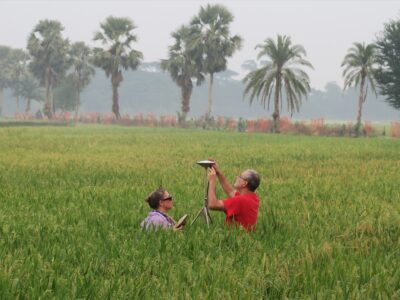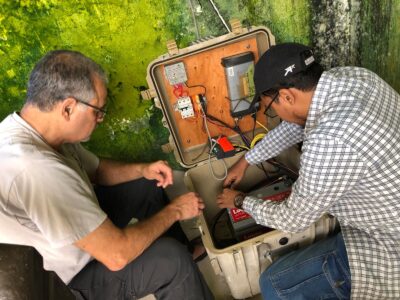
Humayun Akhter, my main collaborator in Bangladesh, joined me at the airport and we flew together to Kolkata. We spent the night at a nondescript hotel near the airport. The next morning, we met up with film makers Doug Prose and Diane LaMacchia in the airport and all flew together to Aizawl, the capital of Mizoram state in NE India. Doug and Diane have funding from NSF to expand the 5-min YouTube video they made about our project two years ago (https://www.youtube.com/watch?v=WTETuqJPygs) to a ½ hour TV special. Their previous films have been shown on PBS.

The Sumatra subduction zone, source of the 2004 earthquake and tsunami, continues to the north where it encounters the Ganges-Brahmaputra Delta. The 15-20 kilometer thick delta sediments are folded and faulted as they enter the subduction zone. Because of the huge amounts of sediments, this is the only subduction zone whose front is subaerial – entirely exposed on land. In Bangladesh we can see the beginning of this process. Here in Mizoram, farther east, the former delta sediments are folded up into a very hilly terrain. The steep slopes are subject to frequent landslides. One that started last October has moved again and blocks the main road from the airport to the city of Aizawl. As a result, we had to take a longer, slower, bumpier and dustier road to get to the city.

We met up with Nano Seeber and Paul Betka from Lamont at breakfast. They have been doing geologic mapping the region and returned to Aizawl late the night before. We spent the day circling the city and visiting outcrops, many ones I had seen my last time here. We had several interesting discussions on differences of interpretation of the strata. I had visited most of these outcrops before, but it was the first time for Humayun. At the end of the day we were joined by

Vineet Gahalaut from the mainland, as the rest of India is considered here. The people here look Asian and the Mizo language is a tonal language in the Tibeto-Burmese family. Plus, almost all Mizo are Christian. Mizoram is part of India, but also distinct, like many of the other states in NE India. Part of the sense of separation is that the 7 NE states are only connected to the rest of India by the narrow 23 km (14 mi.) Siliguri Corridor between Bangladesh and Nepal – the chicken neck. We spent the evening talking with Vineet about future joint projects in this region.
The next day we were joined by Victor Ralte, our partner from Mizoram University, who became a proud father of a fourth daughter last week. We all headed north, visiting geological sites and filming

beautiful vistas, dropping Vineet off at the airport and continuing on to Kolasib, a small town about 70 km north as the crow flies, but probably twice that on the windy roads of Mizoram. We stayed in Hotel Cloud 9. I had been told since I was a child that I was always off on Cloud 9 and now I was actually here. However, the electricity wasn’t for the first few hours, so showers were cold, but the dinner was hot.
The next day we headed still farther north to see some complex faulting associated with the growth of the anticlines – the hills of folded strata. As we examined each outcrop, it was also clear that we were passing through several kilometers of rocks in which the environment that were deposited in shallowed from the inner continental shelf (10s of

meters water depth) to the tidal zone to estuaries like the present Sundarbans to fully fluvial (river). This represents the ancient Brahmaputra Delta passing across this area as it grew southwards. That several kilometers of sediments were deposited while the environment only shallowed by 10s of meters indicates that there was a lot of subsidence to make space for the sediments. I will have to model this when I return.
Stopping for a beautiful sunset over the hills, we finished heading back to Aizawl for a last dinner together. In my room as it turned out since the restaurant closed for some repairs. The six of us ate a mixture of American, Indian, Chinese and Mizo food with plates dishes and ourselves filling all available surfaces. Today, a quick stop at Mizoram University and then back to Kolkata for my last leg before home.






